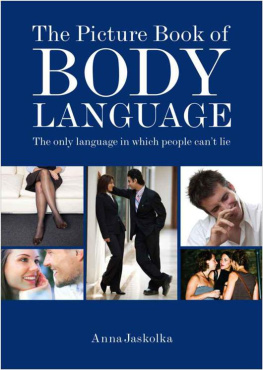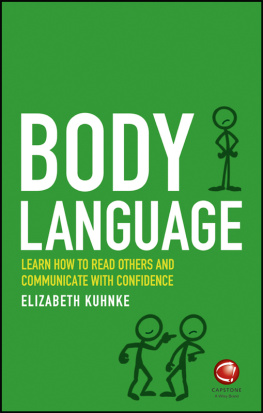ACKNOWLEDGMENTS
These are some of the people who have directly or indirectly contributed to this book, whether they knew it or not:
Dr. John Tickel, Dr. Dennis Waitley, Dr. Andre Davril, Professor Phillip Hunsaker, Trevor Dolby, Armin Gontermann, Lothar Menne, Ray & Ruth Pease, Malcolm Edwards, Ian Marshall, Laura Meehan, Ron & Toby Hale, Darryl Whitby, Susan Lamb, Sadaaki Hayashsi, Deb Mehrtens, Deb Hinckesman, Doreen Carroll, Steve Wright, Derryn Hinch, Dana Reeves, Ronnie Corbett, Vanessa Feltz, Esther Rantzen, Jonathan Coleman, Trish Goddard, Kerri-Anne Kennerley, Bert Newton, Roger Moore, Lenny Henry, Ray Martin, Mike Walsh, Don Lane, Ian Lesley, Anne Diamond, Gerry & Sherry Meadows, Stan Zermarnik, Darrel Somers, Andres Kepes, Leon Byner, Bob Geldof, Vladimir Putin, Andy McNab, John Howard, Nick & Katherine Greiner, Bryce Courtney, Tony & Cherie Blair, Greg & Kathy Owen, Lindy Chamberlain, Mike Stoller, Gerry & Kathy Bradbeer, Ty & Patti Boyd, Mark Victor Hansen, Brian Tracy, Kerry Packer, Ian Botham, Helen Richards, Tony Greig, Simon Townsend, Diana Spencer, Princes William and Harry, Prince Charles, Dr. Desmond Morris, Princess Anne, David & Jan Goodwin, Iven Frangi, Victoria Singer, John Nevin, Richard Otton, Raoul Boielle, Matthew Braund, Doug Constable, George Deveraux, Rob Edmonds, Gerry Hatton, John Hepworth, Bob Heussler, Gay Huber, Ian McKillop, Delia Mills, Pamela Anderson, Wayne Mugridge, Peter Opie, David Rose, Alan White, Rob Winch, Ron Tacchi, Barry Markoff, Christine Maher, Sallie & Geoff Burch, John Fenton, Norman & Glenda Leonard
and
Dorie Simmonds, whose encouragement and enthusiasm
drove us to write this book.
Introduction
___________________________________________________
By a man's fingernails, by his coat-sleeve, by his boots,
by his trouser-knees, by the calluses of his forefinger and
thumb, by his expression, by his shirt-cuffs, by his
movementsby each of these things a man's calling is plainly
revealed. That all united should fail to enlighten the
competent enquirer in any case is almost inconceivable.
SHERLOCK HOLMES, 1892
___________________________________________________
As a young boy, I was always aware that what people said was not always what they meant or were feeling and that it was possible to get others to do what I wanted if I read their real feelings and responded appropriately to their needs. At the age of eleven, I began my sales career selling rubber sponges door-to-door after school to make pocket money and quickly worked out how to tell if someone was likely to buy from me or not. When I knocked on a door, if someone told me to go away but their hands were open and they showed their palms, I knew it was safe to persist with my presentation because, despite how dismissive they may have sounded, they weren't aggressive. If someone told me to go away in a soft voice but used a pointed finger or closed hand, I knew it was time to leave. I loved being a salesperson and was excellent at it. As a teenager, I became a pots-and-pans salesperson, selling at night, and my ability to read people earned me enough money to buy my first piece of property. Selling gave me the opportunity to meet people and study them at close range and to evaluate whether they would buy or not, simply by watching their body language. This skill also proved a bonanza for meeting girls in discos. I could nearly always predict who would say yes to a dance with me and who wouldn't.
I joined the life insurance business at the age of twenty, and went on to break several sales records for the firm I worked for, becoming the youngest person to sell over a million dollars worth of business in my first year. This achievement qualified me for the prestigious Million Dollar Round Table in the U.S.A. As a young man, I was fortunate that the techniques I'd learned as a boy in reading body language while selling pots and pans could be transferred to this new area, and was directly related to the success I could have in any venture involving people.
All Things Are Not What They Seem
The ability to work out what is really happening with a person is simplenot easy, but simple. It's about matching what you see and hear in the environment in which it all happens and drawing probable conclusions. Most people, however, only see the things they think they are seeing. Here's a story to demonstrate the point:
Two men were walking through the woods when they came across a big deep hole.
Wow that looks deep, says one. Let's toss a few pebbles in and see how deep it is.
They threw in a few pebbles and waited, but there was no sound.
Geethat is a really deep hole. Let's throw one of these big rocks in. That should make a noise.
They picked up two football-sized rocks and tossed them into the hole and waited, but still they heard nothing.
There's a railway sleeper over here in the weeds, said one. If we toss that in, it's definitely going to make some noise. They dragged the heavy sleeper over to the hole and heaved it in, but not a sound came from the hole.
Suddenly, out of the nearby woods, a goat appeared, running like the wind. It rushed toward the two men and ran right between them, running as fast as its legs could go. Then it leaped into the air and disappeared into the hole. The two men stood there, astonished at what they'd just seen.
Out of the woods came a farmer who said, Hey! Did you guys see my goat?
You bet we did! It was the craziest thing we've ever seen! It came running like the wind out of the woods and jumped into that hole!
Nah, says the farmer. That couldn't have been my goat. My goat was chained to a railway sleeper!
How Well Do You Know the Back of Your Hand?
Sometimes we say we know something like the back of our hand but experiments prove that less than 5 percent of people can identify the back of their hands from a photograph. The results of a simple experiment we conducted for a television program showed that most people are generally not good at reading body-language signals, either. We set up a large mirror at the end of a long hotel lobby, giving the illusion that, as you entered the hotel, there was a long corridor going through the hotel and out the back of the lobby. We hung large plants from the ceiling to a distance of five feet above the floor so that, as each person entered the lobby, it looked as if another person was entering at the same time from the other end. The other person was not readily recognizable because the plants covered their face, but you could clearly see their body and movement. Each guest observed the other guest for five to six seconds before turning left to the reception desk. When asked if they had recognized the other guest, 85 percent of men answered no. Most men had failed to recognize themselves in a mirror, one saying, You mean that fat, ugly guy? Unsurprisingly, 58 percent of the women said it was a mirror and 30 percent said the other guest looked familiar.
Most men and nearly half of all women
don't know what they look like from the neck down.
How Well Can You Spot Body-Language Contradictions?













